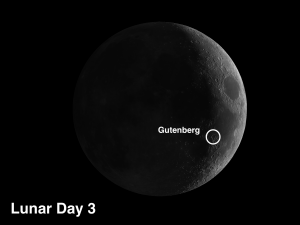The week of April 8-14 takes us from Day 3 to Day 9. This week we will highlight the crater Gutenberg, viewable on Monday and Tuesday evenings. 
Gutenberg: [SE/K14] On Monday and Tuesday night, you check out the western edge of the Sea of Fertility (Mare Fecunditatis) and pay your respects to one of history’s great men.
 Gutenberg crater is not only of historical importance because of its namesake1, it also shows an unusual sequence of crater development. Gutenberg is a large crater (45 mi. in diameter) that is intruded upon by a smaller crater (12 mi. in diameter–Gutenberg E) on its eastern wall. So far so good. But take a close look at the crater immediately adjoining it to the south (Gutenberg C). These craters have violated the usually dependable rule that newer craters are smaller than the older craters they have intruded upon. Gutenberg C is the older crater, while the larger Gutenberg is the interloper.
Gutenberg crater is not only of historical importance because of its namesake1, it also shows an unusual sequence of crater development. Gutenberg is a large crater (45 mi. in diameter) that is intruded upon by a smaller crater (12 mi. in diameter–Gutenberg E) on its eastern wall. So far so good. But take a close look at the crater immediately adjoining it to the south (Gutenberg C). These craters have violated the usually dependable rule that newer craters are smaller than the older craters they have intruded upon. Gutenberg C is the older crater, while the larger Gutenberg is the interloper.
Another item of interest is the simple crater on the southwest rim (Gutenberg A). Simple craters start with rounded floors, then progress to a flat floor resulting from a cascade of boulders that have rolled down the interior walls and settled at the bottom. Rim shadows on bowl-shaped floors will appear as a smooth arc. If the floor is flat because it has been partially filled in, the shadow will be truncated (i.e. the apex will be squared off). Can you tell if the floor of Gutenberg A is bowl-shaped or flat?
More Historical Significance in Space
On April 12, 1961, Soviet cosmonaut Yuri Gagarin became the first man to orbit the Earth.
1 Gutenberg, Johannes: (1398-1468) Gutenberg invented the printing press in 1438 and revolutionized the world. Before Gutenberg it would take a single monk 20 years to copy the Bible, and there were only 30,000 handwritten Bibles in the entire world. Fifty years after Gutenberg there were more than 10 million Bibles in print!
======================
It is highly recommended that you get a copy of Sky and Telescope’s Field Map of the Moon, the very finest Moon map available for use at the telescope. It is available for $10.95 at www.skyandtelescope.com and on Amazon. All features mentioned in this blog will be keyed to the grid on the Field Map and will look like this: Plato: [NW/D9]
Credits:
Courtesy of Gray Photography of Corpus Christi, Texas
Lunar photos: NASA / USGS / BMDO / LROC / ASU / DLR / LOLA / Moon Globe. Used by permission
- Rupes Cauchy: A Best Known Fault on the Moon - July 22, 2024
- Moon Crater Schickard – Crater Floor has Stripes - July 15, 2024
- Moon Craters Langrenus and Vandelinus - July 8, 2024
Hello! I was wondering what are the highlands on the south of Gutenberg crater. There seem to be some mountains as well leading southwards. I took a picture of the 4 day old moon and the mountain shadows are very ominous. I have been trying to find a detailed map of the region on the net but no luck so far.